Timing Gates 101: An introduction to modern speed assessment
Available in:
EN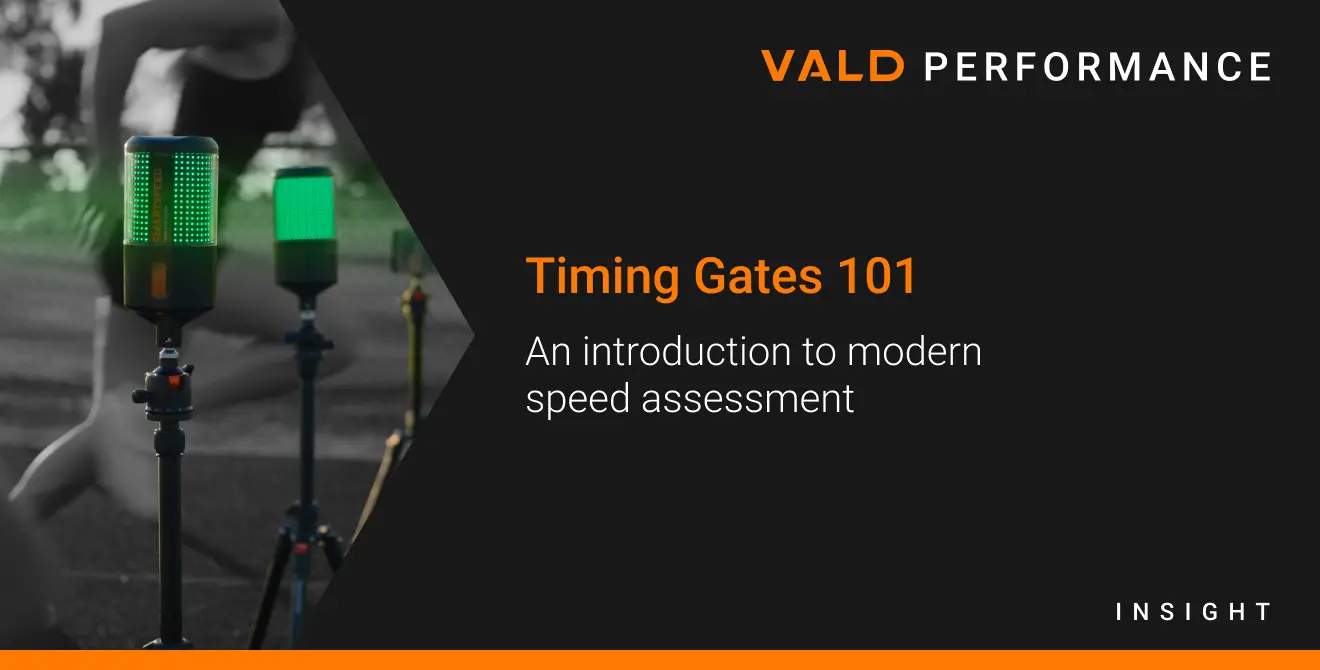
In theory, speed is simple. Stride frequency, stride length, foot strike pattern and ground contact time are the four "big rocks" of speed performance. However, measuring and training the specific qualities of speed often requires lab-based equipment or expensive sensors that are inaccessible to many practitioners.
Ultimately, coaches want to simply and quickly train and test the speed of their athletes. Therefore, affordability, ease of use and effectiveness are key factors when assessing which technology can best achieve these goals. As a result, timing gates typically come out as a frontrunner for speed training and assessment.
Ultimately, coaches want to simply and quickly train and test the speed of their athletes ...timing gates typically come out as a frontrunner for speed training and assessment.
In this article, we will discuss the basics of timing gate technology, the benefits, advantages and features that modern timing gates provide, and some guidelines for practitioners to follow when getting started with performing speed assessments.
Want to dive deeper into speed testing? Check out our Practitioner’s Guide to Speed Testing.

Types of Speed Testing Technology
Speed assessments come in many forms and varieties. To successfully test and improve speed, you must first understand the tools at your disposal, their strengths, weaknesses and their suitability for the specific needs of you and your athletes.
However, in today’s market, there are countless speed assessment options for practitioners and the choices can be overwhelming. Below is a simple comparison of some of the most commonly used modern speed testing technologies.
Each technology has its strengths and limitations, which is why many elite sporting teams and research institutions often employ multiple speed testing technologies. However, timing gates typically remain practitioners’ tool of choice for speed testing due to their accuracy, efficiency, adaptability and affordability.
Each technology has its strengths and limitations... However, timing gates typically remain practitioners’ tool of choice for speed testing due to their accuracy, efficiency, adaptability and affordability.
| Technology | Pros | Cons | |
|---|---|---|---|
 | Stopwatch Manual timing of events by an operator starting and stopping the stopwatch at key time points. | Simple to use, very low cost. | Prone to tester error, may underestimate split times. |
| Timing Gates Time splits are measured as an athlete passes through an infrared or laser beam. | Accurate & efficient; automatic timing reduces error. Some systems are able to measure change of direction (COD) and agility. | Setup needs to be accurate & reliable. Measures time & calculates speed from splits. | |
| Radar Doppler radio waves measure speed as an object moves towards or away from the device. | Measures speed from a distance. Highly accurate and can measure instantaneous speed. | Sensitive to object direction and positioning. Can't measure average speed and difficult to consolidate data. | |
| GPS Useful for outdoor sports; can measure instantaneous speed. Cover large areas. Can measure game-like COD tasks. | Satellite signals calculate speed based on changes in position over time. | Limited by satellite quality. Instantaneous data is less reliable. Large number of metrics and data to sift through. | |
| Inertial Measurement Unit Highly portable and reliable. Provides acceleration and speed data in all three planes. | Accelerometers and gyroscopes measure speed and angular changes in sport. | Affected by collisions or external motion. Calibration needed. Requires a high-level knowledge for analysis. | |
| Motor Technology Useful for strength & conditioning and assessing kinetic & kinematic demands of speed. | The cable is attached to the athlete and motor; speed and force are measured from motorized resistance. | Equipment is expensive and bulky. Requires extensive knowledge for data interpretation. | |
| Optical Tracking Non-invasive, can track multiple athletes and implements (e.g., a ball) at once. | Cameras capture and analyze movement through image processing. | Requires multiple high-quality cameras, a complex setup that is not portable & is very expensive. |
Overview of common speed assessment technologies, outlining the typical pros and cons associated with each device.
The Evolution of Timing Gate Technology
Timing gates first emerged in speed assessment during the 1980s, with the earliest models using infrared photocells to track time-trial speed events such as track sprinting, ski racing and autocross events.
While technological advancements in beam-break detection, data analysis and timing accuracy have given rise to modern timing gate technology such as SmartSpeed, the same core elements of timing gate assessments hold true. Modern timing technology provides accurate, automated timing functions that remove the complexities in setup, analysis and data tracking of traditional speed testing methods.
Modern timing technology provides accurate, automated timing functions that remove the complexities in setup, analysis and data tracking of traditional speed testing methods.
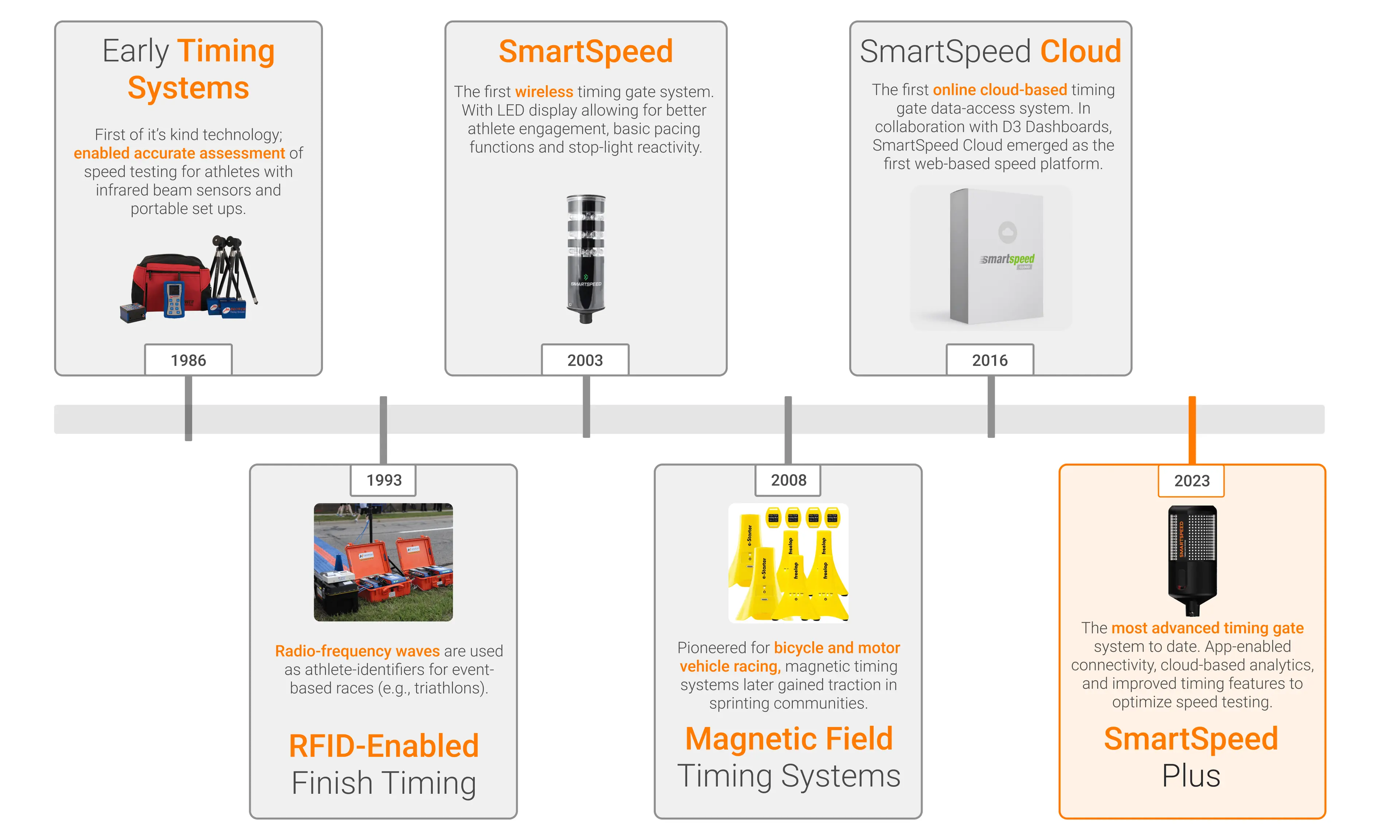
In today’s market, a wide range of timing gate technologies are available to practitioners. The best of these systems allow practitioners to run a wide range of tests and drills, assess multiple athletes at once and consolidate testing data into a single platform (such as VALD Hub) while remaining affordable, portable and easy to use.
These advancements have simplified the speed testing process to make accurate athlete assessment and training accessible to a greater number of practitioners than ever before.
How Timing Gates Work
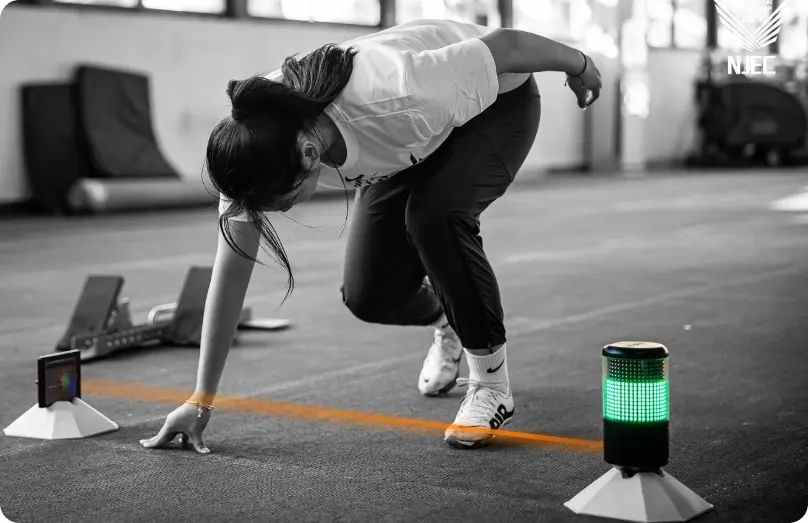
Most common timing gates use "beam" technology, emitting an infrared or (for example, in SmartSpeed Plus’ case) LiDar beam, which is constrained by a reflector, creating an invisible line that acts as a "gate-initiated" signal. SmartSpeed uses this technology to accurately track athlete speed. Beam technology can also be enhanced by smart firmware features such as SmartSpeed’s Error Correction Processing (ECP), whereby erroneous beam breaks from an arm or leg are detected and ignored, ensuring the system only records time intervals when the athlete’s torso has broken the beam.
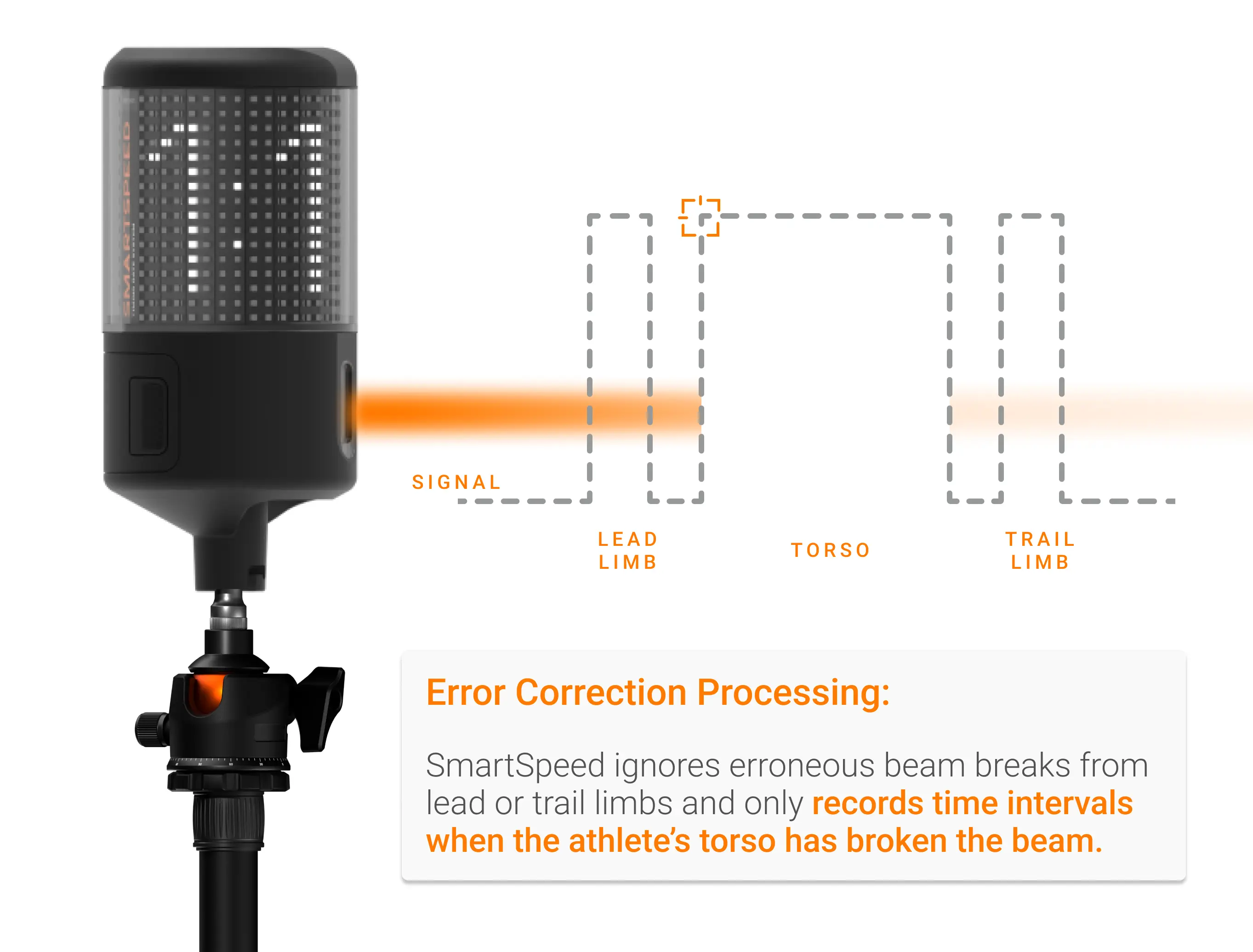
Key Features of Timing Gates
Timing gates have a variety of features, ranging from different hardware functionalities to widely varying apps and software infrastructure that collects, stores and displays their data. However, most timing gates share several commonalities, reflecting their status as a relatively mature technology.
Timing gates have a variety of features, ranging from different hardware functionalities to widely varying apps and software infrastructure... These features can significantly impact users’ experience or their suitability for certain environments, applications, organizations and practitioners.
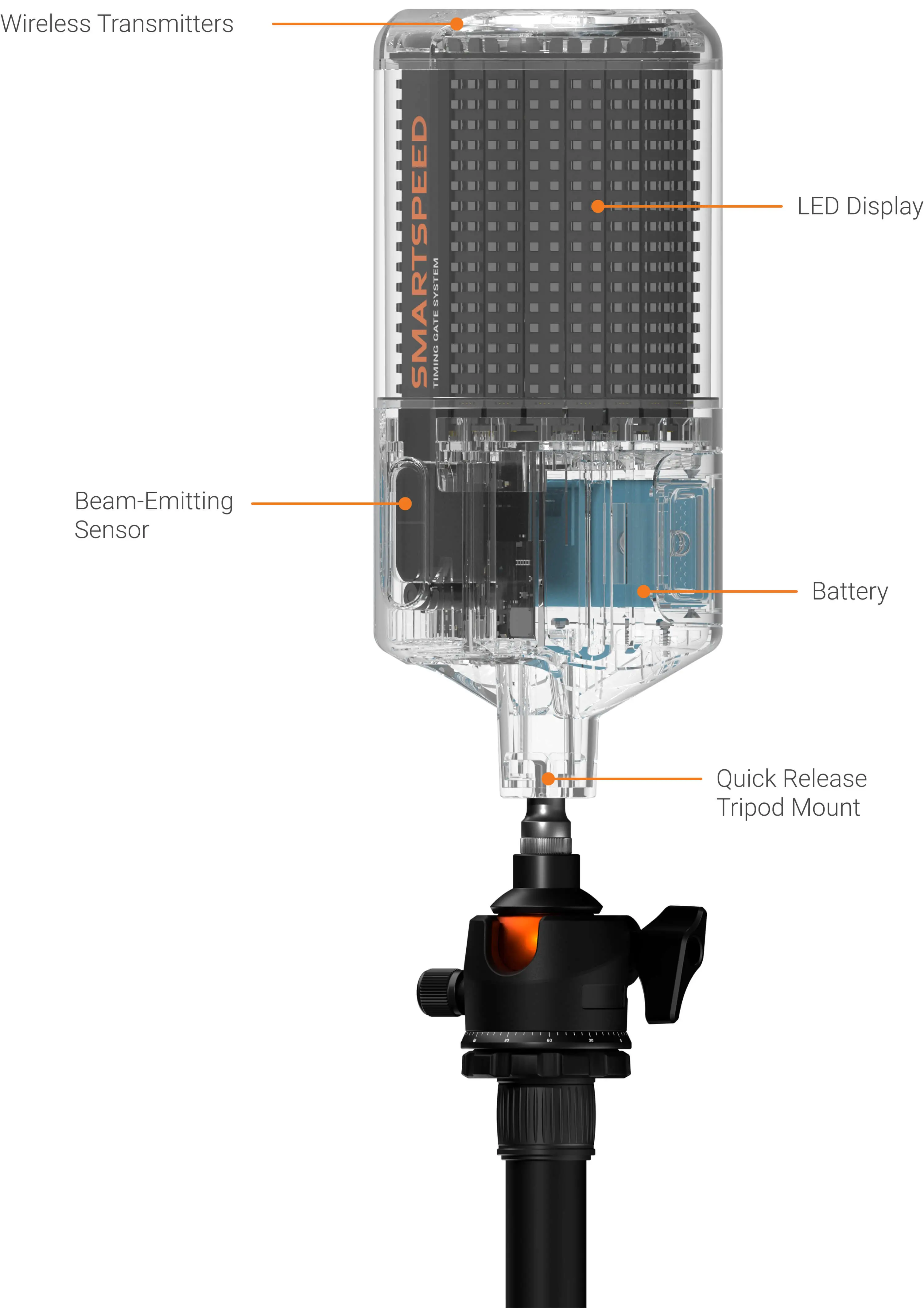
Visualization of the SmartSpeed Plus hardware.
Despite this, like most forms of technology (e.g., smartphones, smart watches, computers and tablets), many models appear similar and ultimately perform many of the same functions; they often have minor yet important differentiating features. These features can significantly impact users’ experience or their suitability for certain environments, applications, organizations and practitioners.
Power Types: Timing gates are typically either wired (mains-powered) or wireless (battery-powered). Battery-powered gates may include embedded batteries or – for example, in SmartSpeed Plus’ case – removable and rechargeable battery packs.
Connectivity: While traditional wired timing gates typically had only wired connectivity (e.g., USB cable), most modern timing gates feature wireless data collection. Because of Bluetooth’s range limitations (typically 10 meters or less for Bluetooth 4 devices or earlier), many timing gate options use other longer-range protocols such as ZigBee to communicate between gates, then reserve Bluetooth for the connection from the primary gate to the data collection device (e.g., smartphone/tablet).
Setup Features: Most modern timing gate systems include tripods to help easily position gates at the correct heights. Aligning gates with their reflectors, however, can often be a delicate task, so some modern gates have features to streamline this process. For example, SmartSpeed Plus uses its LED screen to provide simple prompts to the user to confirm when gates are aligned or misaligned.
Data Collection Apps: Most modern timing gate systems feature a PC- or mobile-compatible data collection app for configuring gates, setting up drills, selecting athletes to be tested, running tests, recording data and displaying results. However, the exact features and usability of these apps can differ substantially and can often have an equal or greater impact on the system’s performance and usability than any hardware feature.
Data Storage: Most modern timing gates allow for data to be automatically uploaded to the cloud to allow for easy data collection and longitudinal tracking. In SmartSpeed’s case, data is uploaded to VALD Hub – VALD’s centralized reporting platform – where the user can generate detailed reports on a range of metrics (including alongside other systems such as ForceDecks and NordBord) immediately.
Test Types: Timing gates are best known for their ability to test straight-line speed, for example, in a 40-yard (y) dash. However, most timing gates are also capable of testing a range of other drills and movements, including agility, COD, reactivity and more. Some systems, such as SmartSpeed, can connect to a range of accessories to unlock even more testing, such as jumps and skill-based drills.
Environmental: Having equipment that suits your environment is critical. Modern timing gates like VALD’s SmartSpeed Plus can tolerate high winds, a wide range of temperatures and even light rain, making them suitable for speed testing in most conditions.
Key Considerations for Using Timing Gates
When testing speed with timing gates, it is crucial to follow best practice protocols to ensure consistency and accuracy in your results. These key considerations help standardize the testing process, allowing for efficient assessments and reliable comparisons.
While most real-world testing environments do not allow every aspect of testing to be controlled, practitioners should be aware of potential sources of variability and control them as best they can.
...practitioners should be aware of potential sources of variability and control them as best they can.
Environmental Conditions
- Outdoors/Indoors: Ensure the testing location remains consistent for all tests. Variations in conditions like heat, wind and humidity can significantly impact the performance of your athletes.
- Surface Type: Standardize the type of surface – turf, grass, court, etc. – as different surfaces can affect traction and running mechanics.
- Footwear: Athletes should wear the same type of footwear for each test to avoid variability in gait patterns and grip.
Testing Conditions
- Scheduling: When assessing an athlete’s ultimate sprint performance, timing within a training schedule should be considered to manage fatigue and optimize for testing-day performance.
- Warm-Up Procedures: Standardize warm-up sequences, duration and intensity. A trial run at 50% effort is recommended before a maximum effort repetition to ensure beam height and placement accuracy.
- Cueing: Use the same verbal cues and demonstrations for every athlete in every session. Consistent cueing ensures all athletes understand the start procedures and expectations, minimizing variability.
Task Setup
- Gate Placement: Ensure gate positions are consistent for every test, ensuring between-gate measurements are as precise as possible. The beam should always be perpendicular to the reflector. If available, use existing line markings (e.g., incremental 10y lines on a football field) or other fixed landmarks to avoid needing to use a tape measure each time.
- Gate Height: Maintain consistent gate height to avoid different body parts breaking the beam during tests. SmartSpeed’s ECP feature will help correct inconsistencies. However, minimizing them where possible is still preferred.
- Lead-In Distance: A 12in (30cm) lead-in distance is recommended for "break beam" starts to avoid false triggers.
- Run-Off Distance: Ensure athletes have sufficient distance (20y or greater) to decelerate after a speed test. Any less and athletes may feel the need to begin decelerating before breaking the final beam.
- In-Beam Starts: Center the beam on the athlete’s midline and ensure the athlete initiates the movement without taking a “false step” to trigger the start.
By considering these key variables, you can ensure that your timing gate tests are reliable and valid. Consistency in environmental conditions, cueing and task setup is key to obtaining accurate and comparable results, allowing for better assessment and tracking of sprint and COD performance.
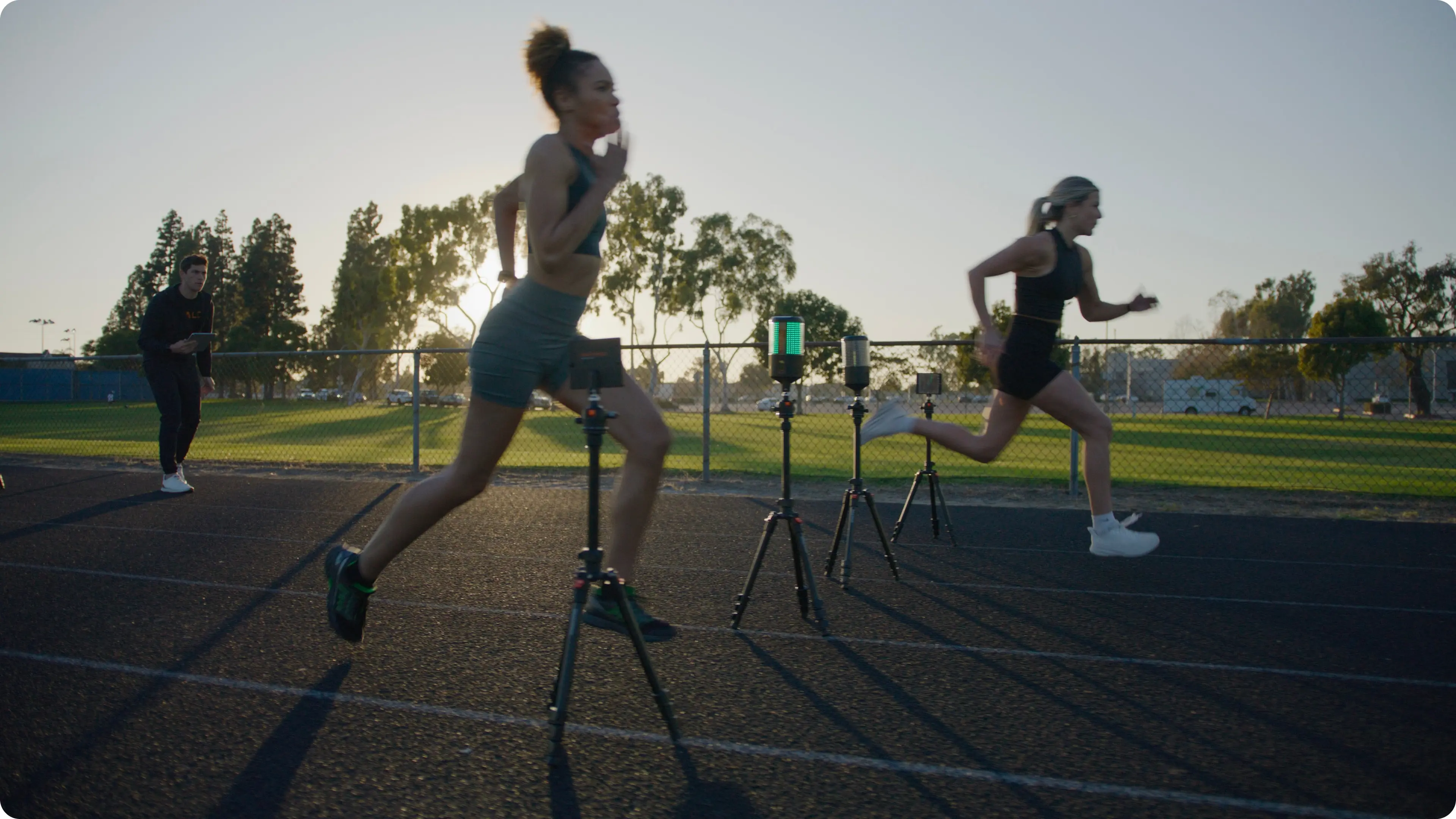
Testing with Timing Gates
Timing gates are often typecast as predominantly straight-line sprinting or acceleration assessment tools. While these are certainly the most popular applications, most modern timing gates are capable of much more. Here, we cover the six key dimensions of speed, each of which timing gates can measure using different test types.
Timing gates are often typecast as straight-line sprinting or acceleration assessment tools ...[while] most modern timing gates are capable of much more.
The Six Dimensions of Speed
Maximum Velocity Sprinting: The fastest possible speed an athlete can reach. It is the easiest-to-understand element of speed, yet difficult to reach in sports outside of track and field events such as the 100- and 200-meter (m) dash. Team sport athletes may only reach this threshold for 1-3% of match-play scenarios (Gualtieri, 2023).
Acceleration: The rate at which an athlete can increase their speed from a stationary position or slow velocity. Most linear acceleration typically occurs in the first 20-30y of a maximal effort locomotive activity; however, world-class sprinters may continue accelerating into the 40 or 50y mark (Slawinski, 2017; Krzysztof, 2013).
Curvilinear Sprinting: While it may be a relatively new training method in team sports, running on a curve is a common sporting demand. In fact, 85% of maximum velocity maneuvers in Premier League Soccer are made in a curvilinear fashion.
- COD: A pre-planned movement executed as quickly as possible. Commonly seen with American Football receivers running specific routes to evade a defender.
- Agility: A movement in reaction to a stimulus in the external environment. Agility adds a layer of decision-making and cognitive demand to that of a standard COD movement. These can most easily be seen in a team sport where a player reacts to their opponent’s actions.
Speed Endurance and Repeated Sprint Ability: Speed endurance is the ability to maintain 95-100% efforts that typically last for 7-15 seconds and utilize full recovery periods (up to 30 minutes) (Haugen, 2019). Repeated sprint ability (RSA) refers to an athlete's capacity to perform shorter bouts of high-effort running (2.5-5 seconds) with short rest periods (typically between 10-60 seconds) (Dawson, 2012). RSA is often seen in training for team sports such as soccer or rugby, whereas speed endurance is often used for track sprinters to ensure chronic high-speed exposure.
Deceleration: Deceleration is the ability to reduce speed as quickly as possible. Often accompanying a COD or agility task, proficient deceleration capacity is vital for sports performance and injury prevention, particularly in non-linear and contact sports such as football. COD assessments with timing gates – where athletes must decelerate and accelerate as quickly as possible – can be a suitable means of calculating deceleration capabilities within a sport-specific context.
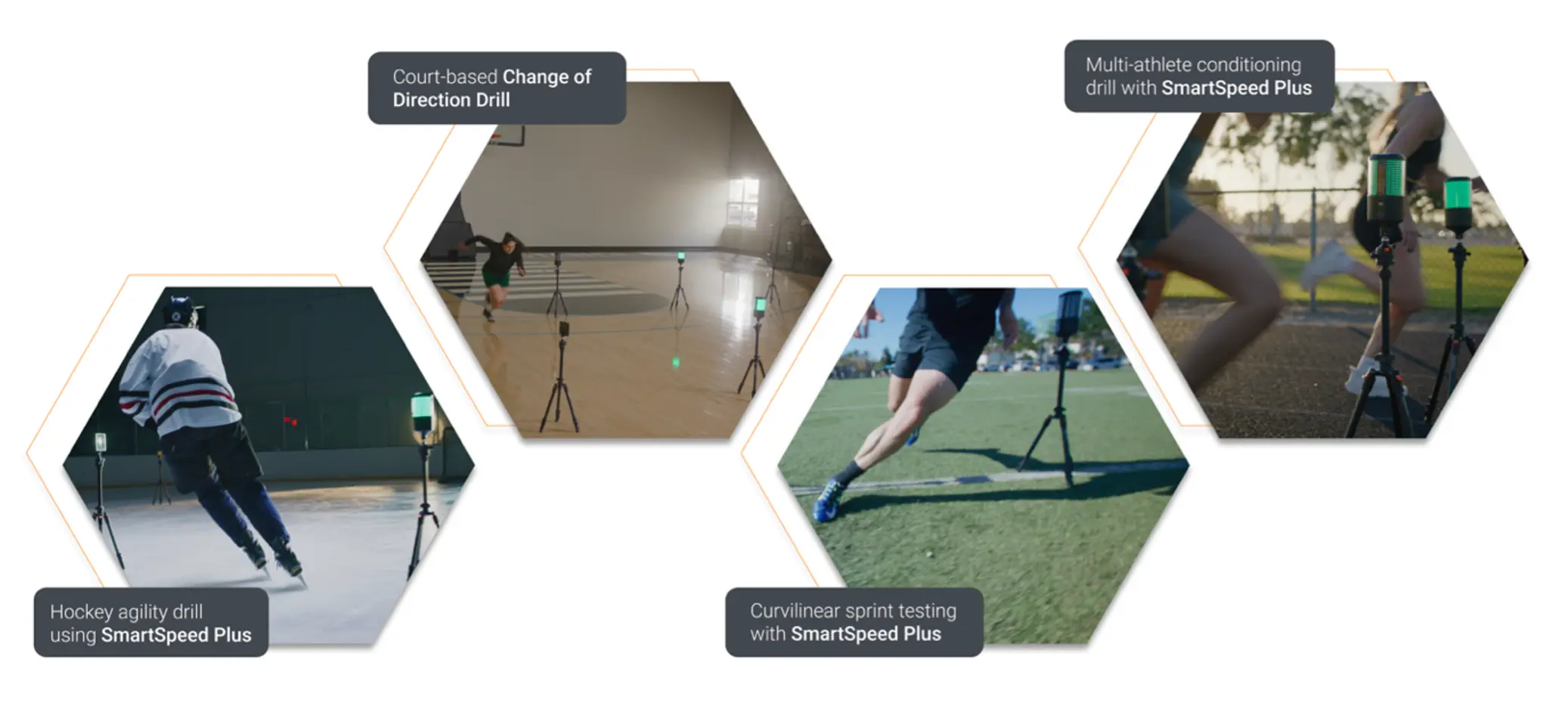
Different sports demand different combinations of these six elements. Performance practitioners should be aware of the speed demands of their athlete’s sport to create a comprehensive speed profile of their athletes.
Measuring The Dimensions of Speed
With an understanding of the dimensions of speed, practitioners can select the most relevant speed assessments to test these qualities. The following table outlines a range of common timing gate drills and descriptions of each drill’s function in speed testing.
| Drill | Description | Diagram |
|---|---|---|
| One-Way Timing | A drill with a defined start and finish where the athlete only moves in one direction. |  |
| Traffic-Light Sprint | Multiple configurations are designed for reactive ability. Timing begins as soon as the light turns green or the buzzer sounds. |  |
| Interval Protocol | Athletes move from Gate A to B (in either direction) in a Fixed Recovery or Fixed Duration format. |  |
| Cut Drills | Multiple configurations test reaction & response to directional signals, speed and agility. Requires at least three timing gates. |  |
| Serpentine | The athlete is cued to perform a predetermined action based on the color presented on display. |  |
| Grid Drills | Athletes are assigned a color to react by running to break the beam. Can be set for time or a number of beam breaks. |  |
| Pacing | Lighting features provide feedback on athlete pacing during known-distance runs. |  |
| Lap Timing | The athlete must start and finish at the same gate while completing a set number of laps around a predetermined track. |
Overview of key drill types with SmartSpeed Plus.
With both preset test options such as these, plus customizable and free-timing capabilities to fit your speed assessments to your specific needs, timing gate technologies like SmartSpeed allow practitioners to assess the different dimensions of speed most applicable to their athletes’ sports.
For more information on SmartSpeed’s testing capabilities, visit our Knowledge Base.
Training with Timing Gates
Although timing gates are known for their testing abilities, they can be an equally effective training tool. With a wide range of drill options such as one-way timing, cut drills, interval protocols and more, timing gates can be a useful tool for training specific demands of different sports.
Although timing gates are known for their testing abilities, they can be an equally effective training tool. With a wide range of drill options such as one-way timing, cut drills, interval protocols and more...
Additionally, engaging features such as SmartSpeed Plus’ 360° wrap-around display can provide real-time feedback, splits and results during drills to drive intent and stoke competition between athletes.
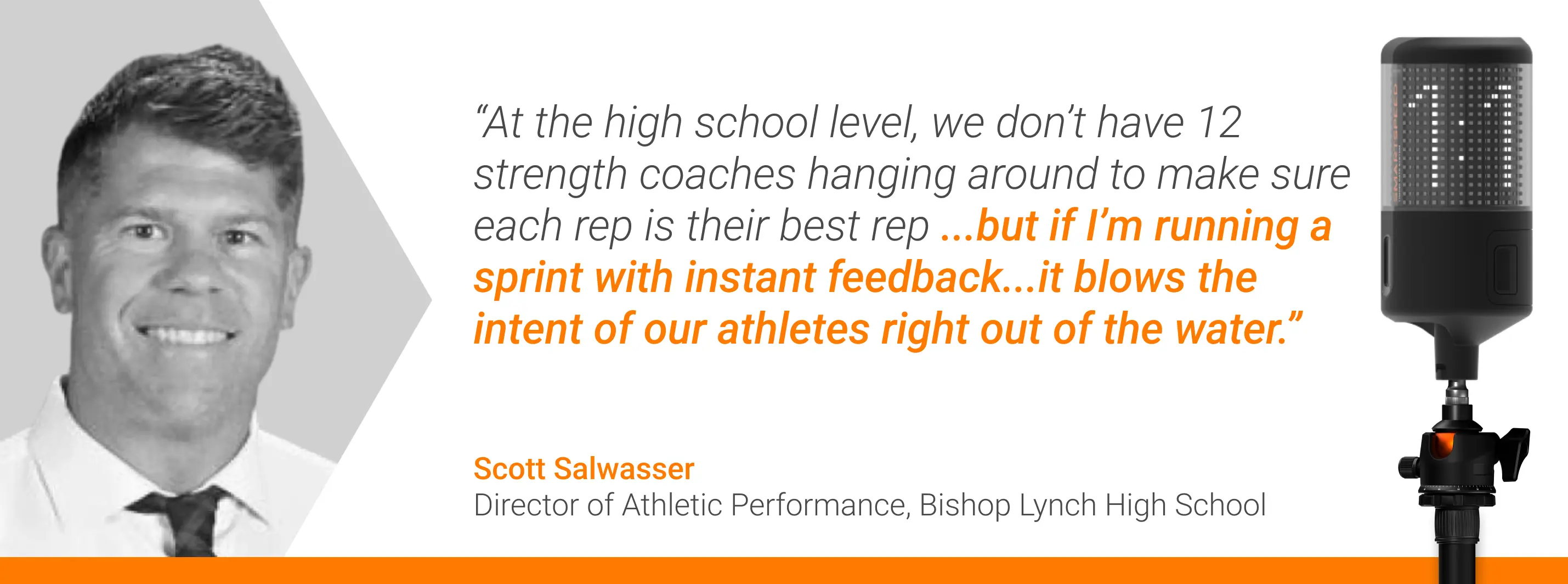
Understanding the Results
With data from human performance technology becoming increasingly voluminous and complex, practitioners can feel comparatively confident about the simplicity of most timing gate data. While outputs of peak velocity, mean velocity, splits and other metrics are available in modern systems such as SmartSpeed, most speed testing data is derived from two variables: time and distance.
To remove potential sources of error, such as those made when calculating speed based on split times and distances, practitioners are encouraged to use time as their primary metric for understanding speed.
This allows the results of a test to remain consistent and valid without the potential for calculation error or inaccurate prediction formulas.
...practitioners are encouraged to use time as their primary metric for understanding speed ...contextualizing raw speed data with normative data or reference points allows practitioners to make decisions and convey results more effectively.
Beyond understanding raw speed data, contextualizing it with normative data or reference points is arguably the most important step, as it allows practitioners to make decisions more easily and convey results to their athletes.
Practitioners may wish to use the following graphs as loose frameworks to conceptualize where an athlete may fit in amongst their peers in three common tests:
- Flying 10m
- 5-10-5 COD
- 40y Acceleration

Once results are collected, modern timing gate software platforms such as VALD Hub centralize all athlete testing data, facilitating simple and effective training decisions through automatic uploads and easy access to longitudinal performance metrics.
As technology continues to advance, innovation ensures that timing gates will continue to offer even more sophisticated insights into speed and movement, further enhancing our understanding of athletic performance.
If you would like to know more about how to integrate VALD’s human measurement technology into your organization to help with the engagement of your clients, please reach out here.
For more information on speed testing, technology and more, check out our Practitioner’s Guide to Speed Testing.

